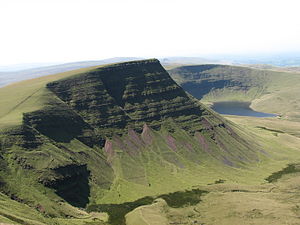Black Mountain (range)


The Black Mountain is a mountain range straddling the county boundary between Carmarthenshire and Brecknockshire and forming the westernmost range of the Brecon Beacons National Park. Its highest point is Fan Brycheiniog on the Brecknockshire side at 2,631ft. The Black Mountain also forms a part of the recently created Fforest Fawr Geopark. [1]
Name
The Black Mountain should not be confused with the Black Mountains in the east of the National Park, nor with a 2,306ft summit in the Black Mountains that is confusingly also called Black Mountain. In his description of a Blak Montayne, the antiquarian John Leland refers to a massif extending between Carmarthen and Monmouth i.e. what is now considered to be the Brecon Beacons in the wider modern sense of that term, thus also including the Black Mountains and the intervening high ground of Fforest Fawr.[1]
The term Carmarthen Fans is sometimes used inaccurately to describe a large part of this massif whereas it should be restricted to the peaks which are arrayed along the northern escarpment, west of the border with Brecknockshire, beyond which (to the east) is Brecknock Fan i.e. Fan Brycheiniog.
Geology
The range stretches approximately from Ammanford in the south-west to Sennybridge in the north-east. The larger part of these hills is formed from Old Red Sandstone though bands of Carboniferous Limestone and of Millstone Grit are important landscape-forming rocks in the south and west of the range owing to their greater resistance to erosion. The area was glaciated during the ice ages and a number of fresh moraines are to be found beneath the spectacular north and east facing sandstone scarps in the north-east of the range. The lakes below the escarpment are also remnants of glacial action.
Drainage

The massif is drained by a number of rivers which flow down the southern dip-slopes of the massif from its main ridge. In contrast the northerly-directed streams tend to be shorter and steeper. The rivers Usk and Tawe have their sources on the eastern flanks of the range whilst the smaller Loughor arises at the western end of the range. Significant right bank tributaries of the Tawe such as the River Giedd and the Afon Twrch and River Amman, a tributary of the Loughor, are the principal southerly-directed watercourses. Two left-bank tributaries of the River Towy, the River Cennen and the Afon Sawdde drain the northwestern slopes of the Black Mountain.[2]
Llyn y Fan Fach
Llyn y Fan Fach (Welsh for 'lake of the small peak') is the smaller and more westerly of two natural lakes within the Black Mountain. It is enclosed within a rock hollow formed as a result of glacial action during the ice ages. It is drained by the Afon Sawdde which cuts through a glacial moraine which in part forms a natural dam. A small artificial dam was constructed in the 1930s to divert some of its waters to boost Llanelli's water supply.[3] Llyn y Fan Fach is associated with the Lady of the Lake legend.
Llyn y Fan Fawr
The lake Llyn y Fan Fawr which lies below the eastern end of the mountain is of similar origin to its westerly neighbour. It is drained by a stream known as Nant y Llyn (Welsh for 'stream of the lake'), whose waters flow into the River Tawe. The surface of Llyn y Fan Fawr lies at about 605 m above sea level.[4]
The lake can be reached on foot by a mile's walk across the moor from the minor Trecastle to Glyntawe road.
Access
Parts of the massif are over three miles from the nearest public road making them some of the most remote areas of the country. Virtually the entire massif consists of land mapped as open country and hence legally accessible to the public on foot under the provisions of the Countryside and Rights of Way Act 2000. In addition the range is crossed from north to south by a number of long bridleways which may be used by mountain bikers and horseriders though long sections of them are very rough and indistinct. The Beacons Way traverses the range roughly from east to west. Increased use of certain sections of path by walkers in recent years has resulted in accelerated erosion, a problem exacerbated by the sometimes thin, gravelly soils and the high rainfall, and has necessitated repairs by the Brecon Beacons National Park Authority.
Cultural associations
The Black Mountain is generally considered to be one of the wildest regions of Wales and is associated with numerous myths such as the Lady of the Lake and Twrch Trwyth. More recent events are commemorated in prose and verse e.g. 'From the Mist to Heaven' written after a tragedy played out on these moors in May 1904.[5] Cribarth on its southeastern margin is known locally as the Sleeping Giant, after the appearance of its profile from Cwm Tawe to the south.
References
- ↑ Toulmin Smith, Lucy (ed.), The Itinerary in Wales of John Leland in or about the years 1536-1539, Vol. 3 Containing Part 6 (The Itinerary in Wales), with a Map, London, 1906
- ↑ Ordnance Survey 1:25,00 scale Explorer map sheet OL12 Brecon Beacons National Park: western area
- ↑ http://www.fforestfawrgeopark.org.uk/understanding/archaeology-industrial-heritage/reservoir-of-fforest-fawr-geopark
- ↑ Ordnance Survey Explorer map OL12 'Brecon Beacons National Park: western area'
- ↑ http://www.breconbeacons.org/fforestfawr/understanding/archaeology-industrial-heritage/geopark-timeline
Coordinates: 51°52′53″N 3°42′31″W / 51.88144°N 3.70848°W